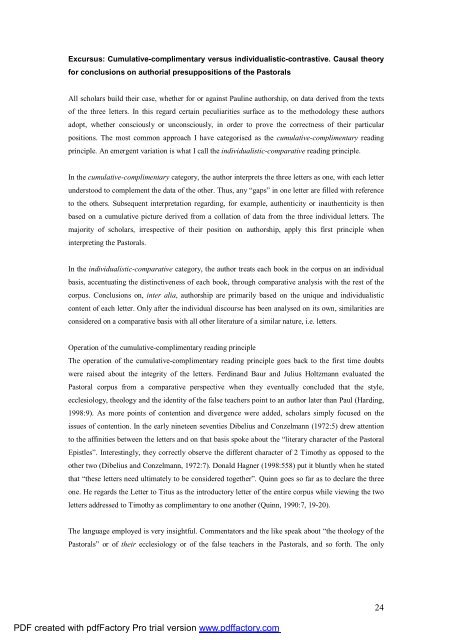A Text centred rhetorical analysis of Paul's Letter to Titus
A Text centred rhetorical analysis of Paul's Letter to Titus
A Text centred rhetorical analysis of Paul's Letter to Titus
Create successful ePaper yourself
Turn your PDF publications into a flip-book with our unique Google optimized e-Paper software.
Excursus: Cumulative-complimentary versus individualistic-contrastive. Causal theory<br />
for conclusions on authorial presuppositions <strong>of</strong> the Pas<strong>to</strong>rals<br />
All scholars build their case, whether for or against Pauline authorship, on data derived from the texts<br />
<strong>of</strong> the three letters. In this regard certain peculiarities surface as <strong>to</strong> the methodology these authors<br />
adopt, whether consciously or unconsciously, in order <strong>to</strong> prove the correctness <strong>of</strong> their particular<br />
positions. The most common approach I have categorised as the cumulative-complimentary reading<br />
principle. An emergent variation is what I call the individualistic-comparative reading principle.<br />
In the cumulative-complimentary category, the author interprets the three letters as one, with each letter<br />
unders<strong>to</strong>od <strong>to</strong> complement the data <strong>of</strong> the other. Thus, any “gaps” in one letter are filled with reference<br />
<strong>to</strong> the others. Subsequent interpretation regarding, for example, authenticity or inauthenticity is then<br />
based on a cumulative picture derived from a collation <strong>of</strong> data from the three individual letters. The<br />
majority <strong>of</strong> scholars, irrespective <strong>of</strong> their position on authorship, apply this first principle when<br />
interpreting the Pas<strong>to</strong>rals.<br />
In the individualistic-comparative category, the author treats each book in the corpus on an individual<br />
basis, accentuating the distinctiveness <strong>of</strong> each book, through comparative <strong>analysis</strong> with the rest <strong>of</strong> the<br />
corpus. Conclusions on, inter alia, authorship are primarily based on the unique and individualistic<br />
content <strong>of</strong> each letter. Only after the individual discourse has been analysed on its own, similarities are<br />
considered on a comparative basis with all other literature <strong>of</strong> a similar nature, i.e. letters.<br />
Operation <strong>of</strong> the cumulative-complimentary reading principle<br />
The operation <strong>of</strong> the cumulative-complimentary reading principle goes back <strong>to</strong> the first time doubts<br />
were raised about the integrity <strong>of</strong> the letters. Ferdinand Baur and Julius Holtzmann evaluated the<br />
Pas<strong>to</strong>ral corpus from a comparative perspective when they eventually concluded that the style,<br />
ecclesiology, theology and the identity <strong>of</strong> the false teachers point <strong>to</strong> an author later than Paul (Harding,<br />
1998:9). As more points <strong>of</strong> contention and divergence were added, scholars simply focused on the<br />
issues <strong>of</strong> contention. In the early nineteen seventies Dibelius and Conzelmann (1972:5) drew attention<br />
<strong>to</strong> the affinities between the letters and on that basis spoke about the “literary character <strong>of</strong> the Pas<strong>to</strong>ral<br />
Epistles”. Interestingly, they correctly observe the different character <strong>of</strong> 2 Timothy as opposed <strong>to</strong> the<br />
other two (Dibelius and Conzelmann, 1972:7). Donald Hagner (1998:558) put it bluntly when he stated<br />
that “these letters need ultimately <strong>to</strong> be considered <strong>to</strong>gether”. Quinn goes so far as <strong>to</strong> declare the three<br />
one. He regards the <strong>Letter</strong> <strong>to</strong> <strong>Titus</strong> as the introduc<strong>to</strong>ry letter <strong>of</strong> the entire corpus while viewing the two<br />
letters addressed <strong>to</strong> Timothy as complimentary <strong>to</strong> one another (Quinn, 1990:7, 19-20).<br />
The language employed is very insightful. Commenta<strong>to</strong>rs and the like speak about “the theology <strong>of</strong> the<br />
Pas<strong>to</strong>rals” or <strong>of</strong> their ecclesiology or <strong>of</strong> the false teachers in the Pas<strong>to</strong>rals, and so forth. The only<br />
PDF created with pdfFac<strong>to</strong>ry Pro trial version www.pdffac<strong>to</strong>ry.com<br />
24

















